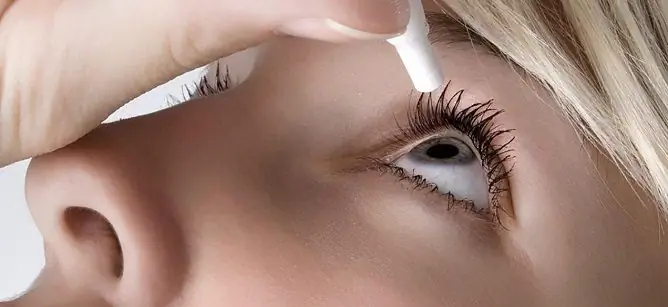- Author Rachel Wainwright [email protected].
- Public 2023-12-15 07:39.
- Last modified 2025-11-02 20:14.
Sanorin
Sanorin: instructions for use and reviews
- 1. Release form and composition
- 2. Pharmacological properties
- 3. Indications for use
- 4. Contraindications
- 5. Method of application and dosage
- 6. Side effects
- 7. Overdose
- 8. Special instructions
- 9. Application during pregnancy and lactation
- 10. Drug interactions
- 11. Analogs
- 12. Terms and conditions of storage
- 13. Terms of dispensing from pharmacies
- 14. Reviews
- 15. Price in pharmacies
Latin name: Sanorin
ATX code: R01AA08
Active ingredient: naphazoline (naphazoline)
Manufacturer: IVAX Pharmaceuticals sro, Teva Czech Industries sro, Czech Republic; Xanthis Pharma Limited, Cyprus
Description and photo update: 2019-13-08
Prices in pharmacies: from 108 rubles.
Buy

Sanorin is a drug of vasoconstrictor and anti-congestive action for local use in otorhinolaryngological practice.
Release form and composition
Sanorin comes in the following forms:
- nasal drops 0.05% and 0.1%: in the form of a transparent colorless liquid (10 ml in dark glass dropper bottles, one bottle in a cardboard box);
- nasal spray 0.1%: in the form of a colorless transparent liquid, odorless and without visible particles (10 ml in plastic bottles with a mechanical dispensing applicator, one bottle in a cardboard box).
Composition of 1 ml drops:
- active substance: naphazoline nitrate - 0.5 mg or 1 mg;
- auxiliary components: methyl parahydroxybenzoate, boric acid, water, ethylenediamine.
Composition of 1 ml spray:
- active substance: naphazoline nitrate - 1 mg;
- auxiliary components: methyl parahydroxybenzoate, boric acid, water, ethylenediamine.
Pharmacological properties
Pharmacodynamics
Naphazoline is an alpha 2 -adrenomimetic that directly stimulates alpha-adrenergic receptors localized in the sympathetic nervous system. Intranasal administration causes a pronounced, rapid and prolonged vasoconstrictor effect on the vessels of the paranasal sinuses and mucous membranes of the nose, as well as the nasopharynx. It is expressed in a decrease in puffiness and hyperemia, as a result of which the patency of the nasal passages improves and the relief of nasal breathing is observed. The patency of the Eustachian tubes also improves. The therapeutic effect is usually observed already 5 minutes after the application of Sanorin and lasts about 4-6 hours.
Pharmacokinetics
There is no information regarding the metabolism, distribution and elimination of naphazoline from the human body.
Indications for use
- sinusitis;
- acute rhinitis of various origins;
- laryngitis;
- otitis media (as an additional agent that reduces swelling of the nasopharyngeal mucosa);
- eustachitis;
- nosebleeds (if necessary to stop them);
- reduction of edema of the mucous membranes of the nasopharynx, nasal cavity and paranasal sinuses during medical and diagnostic procedures.
Contraindications
Absolute:
- atrophic rhinitis;
- chronic rhinitis;
- severe atherosclerosis;
- arterial hypertension;
- tachycardia;
- severe eye diseases;
- angle-closure glaucoma;
- diabetes;
- thyrotoxicosis;
- simultaneous use of monoamine oxidase inhibitors and a period up to two weeks after the end of their intake;
- children under two years of age (Sanorin in the form of nasal drops 0.05%);
- children and adolescents up to 15 years old (Sanorin in the form of a spray and nasal drops 0.1%);
- hypersensitivity to any component of the drug.
Relative (Sanorin is used with caution):
- cardiac ischemia;
- pheochromocytoma;
- hyperplasia of the prostate;
- period of breastfeeding;
- period of pregnancy.
Instructions for use of Sanorin: method and dosage
Spray and drops of Sanorin are used intranasally.
For sinusitis, acute rhinitis, laryngitis, eustachitis, and to facilitate the procedure of rhinoscopy, adults and adolescents over 15 years of age are prescribed 1-3 drops of Sanorin in the form of 0.1% nasal drops or 1-3 doses of Sanorin spray in each nostril. Frequency rate of application - 2-3 times a day.
In children and adolescents aged 2-15 years, nasal drops are used 0.05%. The recommended dose is 1-2 drops in each nostril 2-3 times a day. The interval between instillations should be at least 4 hours.
Sanorin is used for a short time: in adult patients - no more than 7 days, in children - a maximum of 3 days. With the relief of nasal breathing, the drug can be canceled earlier. Re-instillation or injection is possible after a few days.
To stop nosebleeds, a cotton swab moistened with a 0.05% concentration of Sanorin is placed in the nasal passage.
Nasal drops of 0.05% can be used as an additional agent in the treatment of bacterial conjunctivitis. For this purpose, Sanorin is instilled 1-2 drops into each conjunctival sac 3-4 times a day.
Before the first injection of the spray, it is recommended to press the dispenser several times until a compact aerosol cloud appears. Before use, it is necessary to remove the protective cap and, while holding the bottle in an upright position, insert the end of the device into the nasal passage, then quickly and sharply press the applicator. Immediately after injection, inhale lightly through the nose and close the applicator with a protective cap.
Side effects
- digestive system: nausea (very rare);
- central nervous system: irritability and headache (very rare);
- cardiovascular system: increased blood pressure and tachycardia (very rare);
- other reactions: rash, excessive sweating and allergic reactions (very rare).
With increased individual sensitivity, local reactions may occur in the form of dryness and a burning sensation in the nasal cavity. After cessation of exposure (in rare cases), edema and reactive hyperemia of the nasal mucosa are possible. With frequent and prolonged (more than one week) use of Sanorin, irritation, atrophy of the nasal mucosa and chronic obstruction of the nasal passages may occur.
When used in recommended doses, the drug is generally well tolerated.
Overdose
An overdose of Sanorin can be determined by symptoms such as palpitations, tachycardia, increased blood pressure, nervousness, tremors, headache, excessive sweating. In some cases, cyanosis, nausea, breathing disorders and mental activity are observed. Strong depression of the central nervous system is accompanied by a decrease in body temperature, intensification of sweating, drowsiness, weakness, bradycardia, collapse, in rare cases - a coma.
As a treatment, it is recommended to cancel Sanorin and prescribe symptomatic therapy.
special instructions
It is necessary to avoid long-term treatment with Sanorin, since with prolonged use, the phenomenon of tachyphylaxis is observed (a decrease in the vasoconstrictor effect of the drug). To avoid side effects from the nervous and cardiovascular systems, the recommended doses should not be exceeded.
Sanorin can have a resorptive effect.
The drug is prescribed with caution to patients before general anesthesia with anesthetics that increase myocardial sensitivity to sympathomimetics (for example, halothane), especially in patients with bronchial asthma.
According to the instructions, Sanorin does not affect a person's ability to drive vehicles and perform other work associated with increased concentration of attention and quick reactions.
Application during pregnancy and lactation
If treatment with Sanorin is necessary during pregnancy / breastfeeding, it is necessary to correlate the expected benefits of therapy for the mother and the potential risk to the fetus / child. There is no information on the penetration of naphazoline through the placental barrier, as well as into breast milk.
Drug interactions
Tricyclic antidepressants and monoamine oxidase inhibitors, when used simultaneously with naphazoline, can cause an increase in blood pressure (the same effect persists for 14 days after they are canceled, therefore this combination is contraindicated).
Sanorin slows down the absorption of local anesthetics, which leads to an increase in the duration of their action.
Analogs
The analogues of Sanorin are: Naphtizin, Naphazolin.
Terms and conditions of storage
Store in a dark place at a temperature of 10-25 ° C. Keep out of the reach of children.
Shelf life is 4 years.
An opened bottle with the drug must be used within 1 month.
Terms of dispensing from pharmacies
Available without a prescription.
Reviews about Sanorin
Most often, pregnant women leave reviews about Sanorin. Some of them during this period cannot do without the drug, which has always helped them. Some of the pregnant women were even prescribed by a doctor, and those who already have children reported that they used it during pregnancy without any tangible harm to the child.
Often, the drug is also used in children, but with a lower content of the active component. However, experts do not recommend using Sanorin in very young children.
Many patients are addicted to naphazoline. This is due to the fact that it eliminates nasal congestion well, as a result of which patients begin to use the drug without observing the dosage and frequency of instillation during treatment. At the same time, it soon becomes noticeable that they can breathe normally only after instillation of Sanorin, that is, drug dependence is formed. This effect is due to the loss of the nasal mucosa of the ability to function normally, which leads to the appearance of new puffiness and the need to use the agent. It is quite difficult to get rid of addiction: the patient will have to go through a difficult period of regeneration of the nasal mucous membranes, accompanied by difficulty in nasal breathing, headache and other unpleasant symptoms. For this reason, Sanorin should only be used as an aid in the acute stage of the disease. If used for a long time and in high doses, treatment of the consequences can be expensive and time consuming.
Price for Sanorin in pharmacies
The price of Sanorin in the form of 0.05% nasal drops is approximately 125-149 rubles, and 0.1% drops are 121-127 rubles (for a 10 ml bottle). Nasal spray 0.1% can be purchased for 188-209 rubles (for a 10 ml bottle).
Sanorin: prices in online pharmacies
|
Drug name Price Pharmacy |
|
Sanorin 0.05% spray 10 ml 1 pc. 108 RUB Buy |
|
Sanorin 0.1% nasal drops 10 ml 1 pc. 110 RUB Buy |
|
Sanorin took drops. for children 0.05% 10ml 114 RUB Buy |
|
Sanorin 0.05% nasal drops for children 10 ml 1 pc. 114 RUB Buy |
|
Sanorin took drops. 0.1% 10ml 121 RUB Buy |
|
Sanorin with eucalyptus oil 0.1% nasal drops 10 ml 1 pc. 122 RUB Buy |
|
Reviews Sanorin with eucalyptus oil 122 RUB Buy |
|
Sanorin 0.1% nasal spray 10 ml 1 pc. 132 RUB Buy |
|
Sanorin nasal drops with eucalyptus oil. emulsion 0.1% 10ml 135 RUB Buy |
|
Sanorin nasal spray. 0.1% 10ml 146 r Buy |
|
Sanorin Loris topical spray 30 ml 1 pc. RUB 150 Buy |
| See all offers from pharmacies |

Anna Kozlova Medical journalist About the author
Education: Rostov State Medical University, specialty "General Medicine".
Information about the drug is generalized, provided for informational purposes only and does not replace the official instructions. Self-medication is hazardous to health!






